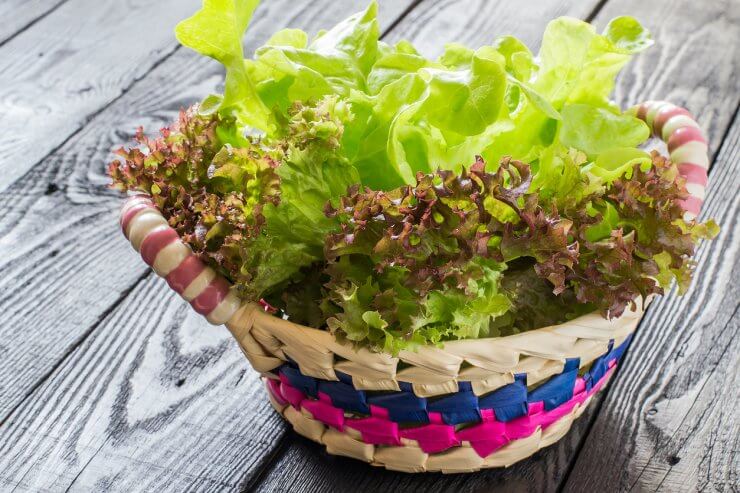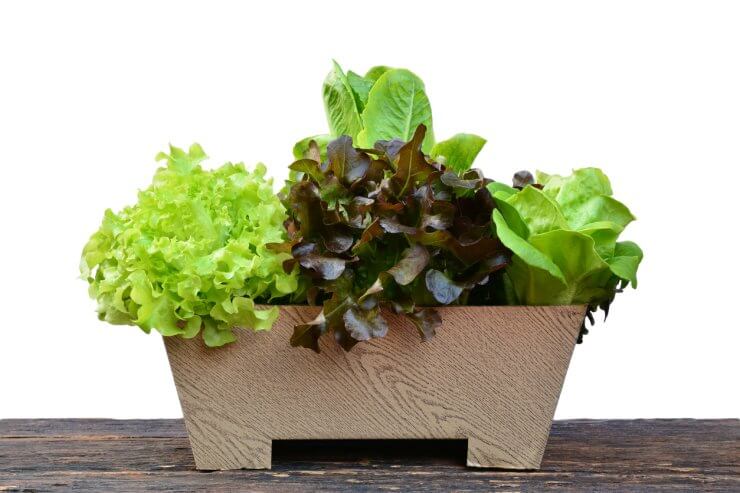
I love adding some fresh, crunchy lettuce to my meals. Lettuce is delightful on its own as a simple salad with a dash of olive oil, and it’s great in sandwiches or as a bed for grains. Living in a cooler climate, though, I had to learn how to grow lettuce in containers if I wanted to enjoy these crisp greens in the winter.
Luckily, lettuce enjoys cooler weather, so I don’t need to turn the heat up to some ridiculous degree. Plus, lettuce doesn’t need a ton of sun to grow, so I don’t need to worry about grow lights, although a south-facing window is helpful.
In other words, lettuce is an ideal vegetable for growing indoors in the winter. So, here’s what I know about how to grow lettuce in containers, inside, in cold weather.
Discover 7 top tips for growing, harvesting, and enjoying tomatoes from your home garden—when you access the FREE guide The Best Way to Grow Tomatoes, right now!

Cold outside? Here’s how to grow lettuce in containers
Figuring out how to grow lettuce in containers will change your life. I promise. It’s such a joy to be able to grab some fresh greens on a cold, dark winter day.
Lucky for us, it’s not all that hard. It’s just a matter of getting the four necessities right: soil, water, temperature, and sun.
Most lettuce varieties have fairly shallow roots, so you don’t need a very deep pot. You might, however, want to use something with a large diameter or length so you can grow plenty of lettuce and maximize your space.
Lettuce will grow in any container as long as there is good drainage, so the roots don’t get waterlogged. I like terra cotta, personally, because it absorbs some of the moisture and lets the soil breathe, but you can use anything from coffee cans to wooden crates. But, again, just be sure there is drainage (or add some holes yourself).
Now let’s go over those four necessities.
Soil. It’s probably no surprise that, like almost all vegetables, lettuce appreciates rich, well-drained soil. If you can mix some seasoned compost in there, that will add some good nutrition to the soil.
Water. Water can be tricky. Lettuce likes plenty of moisture, but you don’t want to end up with root rot. The balance is keeping the soil moist, neither allowing it to dry out nor become too wet. Since lettuce has shallow roots, you may need to water more often than you would with some other vegetables. I hate to be the bearer of a non-answer here, but there are so many variables (container material, soil composition, temperature, and so on) that your best bet is to check on your lettuce regularly until you determine how often it needs water.
Temperature. Lettuce seeds will germinate best around 70 degrees Fahrenheit. Once your lettuce is established, the happy place for most varieties is about 60 to 65 degrees. For me, this works out well. I can turn the heat to a comfortable level in my home, while the lettuce can hang out in a cool spot by the window, so it gets plenty of sunshine.
Sunlight. Lettuce does like the sunlight, and it will grow more quickly when it gets plenty of sun. However, lettuce also tolerates shade. Since we’re talking about how to grow lettuce in containers indoors in the winter, the approach is pretty straightforward here. Find a sunny spot in a southern-facing window for your container. Lettuce still needs six to eight hours of sunlight, so you don’t need to worry about it getting too much sun in the winter.
There you have it. It really is that simple.
The nice thing is that once you know how to grow lettuce in containers in the winter, you can use the same approach to grow lettuce in the summer when it’s usually too hot outside for these greens. Just be aware that you might need to find a spot with less direct sunlight.
Have you tried growing lettuce in containers over the winter? What tips would you add?
Discover 7 top tips for growing, harvesting, and enjoying tomatoes from your home garden—when you access the FREE guide The Best Way to Grow Tomatoes, right now!





Good to know! It’s still snowing here and I’m jonesing for some fresh greens. Buttercrisp anyone?